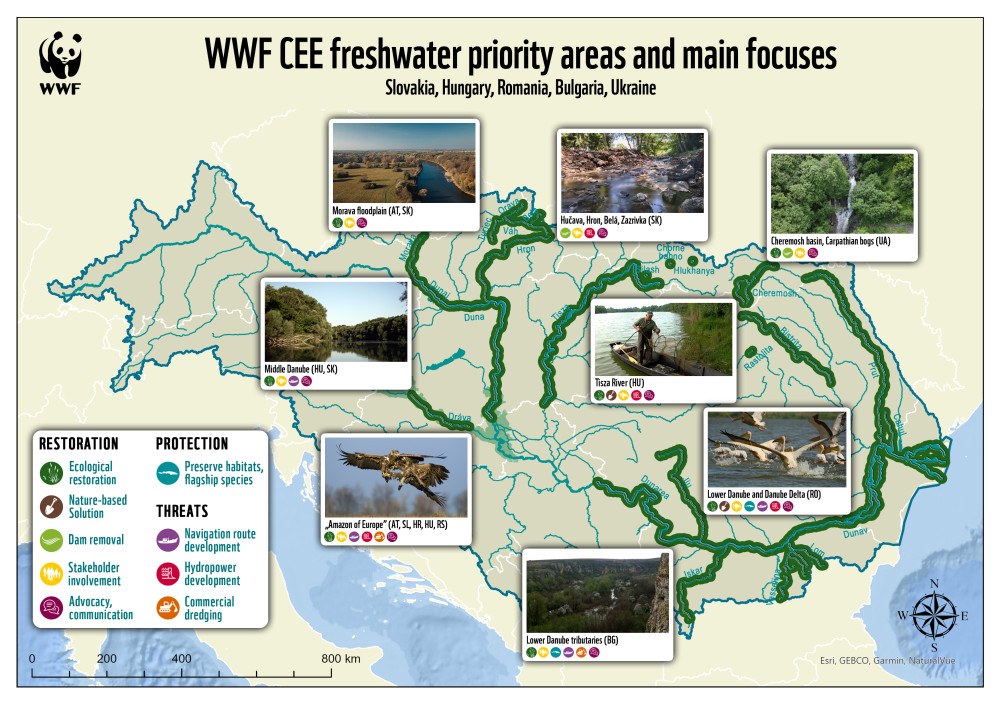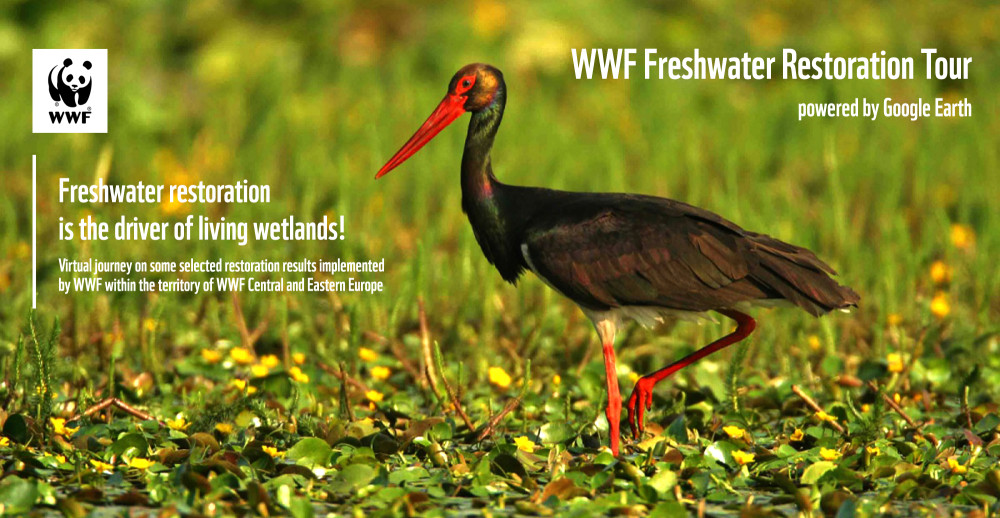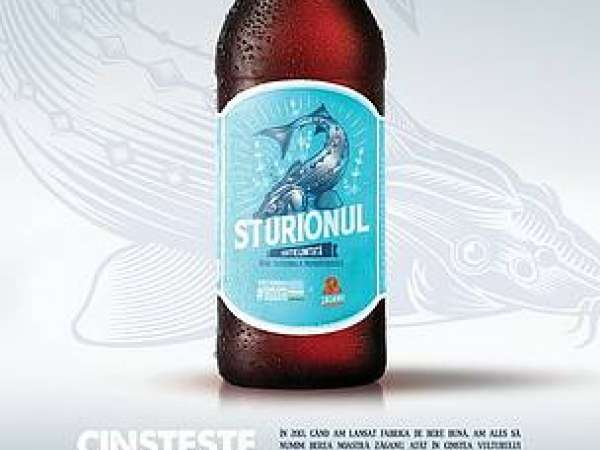WHY DO WE GET INVOLVED? MAIN PROBLEMS IN CEE-RIVERS
Over the past 150 years, the Danube Basin and its rivers and wetlands have been artificially altered, 80% of the Danube and its main tributaries’ floodplains have been lost. Due to economic development, climate change and resulting pressures originating from unsustainable water use, the environmental threats increased rapidly. There is a large number of factors threatening the freshwater biodiversity, from nutrient, organic and hazardous pollution to the impact of river infrastructure.
WWF-CEE mainly focuses on the latter ones caused by:
- Unsustainable flood management: Dikes cutting off rivers from their floodplains have caused the loss floodplain habitat territory and natural flood and water retention capacities. Most of the former floodplains were drained for intensive agriculture use.
- Hydropower development: Small, medium or large (hydropower-) dams interrupt the river continuity, block the natural sediment transport, restrict natural movements of fish (sturgeons etc.) or other species, change the water flow, quantity and quality. The trapped sediment by the dams as well as the commercial dredging cause serious sediment deficits downstream in the lower river stretches to the Black Sea resulting severe riverbed erosion and reduction of groundwater level in the connected areas.
- Navigation and other river regulations: In order to improve the river navigability there was an increase in river regulation works (built training structures, fixed riverbanks, dredging, shortcuts etc.). The interventions and periodical waterway maintenance works - worsened by lack of sediment load - cause intensive riverbed erosion, which decreases the water level and affects negatively all river and water uses and dry up remaining floodplains.
... these processes started in the past, their effects and consequences are still ongoing, and new harmful projects are in still in the pipeline.
The above mentioned mainly physical changes together with other pressures (overuse of water, intensive agriculture practices, urbanization etc.) have made the Danube basin even more vulnerable to climate change. People living here have to cope with severe droughts or floods on the same land, natural habitats are deteriorating day by day. Nature-based solutions can help us to mitigate the negative consequences and restore function of rivers and former floodplains for the benefit of nature and people.
WHERE DO WE WORK? FRESHWATER PRIORITY AREAS IN A NUTSHELL
WWF Central and Eastern Europe focuses on ecologically valuable freshwater systems such as the Hron river in Slovakia, the Tisza river in Hungary, the Cheremosh Basin in Ukraine, the five-country Mura-Drava-Danube Biosphere Reserve or the Middle and Lower Danube with the great Danube Delta.
|
|
|
WWF-CEE freshwater priority areas in the Danube Basin (Slovakia, Hungary, Romania, Bulgaria, Moldova) |
WHAT DO WE DO?
While many valuable freshwater habitats remain, more have been lost in the recent past as river side arms were cut-off, dykes built and floodplains drained. WWF-CEE is demonstrating the feasibility and value of restoration and good management. We promote solutions that have multiple benefits, for nature and people.
Key pillars of the Freshwater programme:
-
PROTECTION - Prevent new damage: In order to preserve the still high ecological value of this region, it is important to stop or at least mitigate the negative consequences of new infrastructure projects such as unsustainable hydropower, flood protection and navigation infrastructure development or sediment extraction. We focus on selected threatening projects in biodiversity hotspots of WWF-CEE priority landscapes. We engage in project development and demonstrate how proper stakeholder involvement and good planning can lead to good results. We also choose cases to create national precedents with legal actions (and communication) to signal to project promoters and authorities that unsustainable projects will not be successful.
-
RESTORATION - We promote, initiate and implement river, floodplain and wetland restoration in already damaged riverine habitats. We focus on pilot projects that demonstrate feasibility and multiple (ecological and socio-economic) benefits of restoration. They also serve as opportunity to build up trust or achieve appreciation of WWF by key authorities relevant in upscaling efforts. By involving local stakeholders, we ensure local ownership and support.
-
Nature-based solutions – reconnection of former floodplain areas to improve the water regime on drying up landscapes in cooperation with local communities for their benefits.
-
Dam removal activities – focusing on obsolete dams to improve the river continuity that ensures the continuity between riverine habitats.
-
-
ADVOCACY - Improve enabling environment: For both pillars, we influence governance frameworks, strategic planning processes and financial flows and engage decision makers and stakeholders to set enabling conditions for upscaling, larger scale restorations and prevention of new threats.
We use the experience and results achieved at local level through our pilot work to shape convincing and impactful policy advocacy action at national, regional and EU level. The higher goal is to influence legislation, policies and financial streams for better water resources, conservation planning and implementation in the countries on a larger scale.
HIGHLIGHTS OF THE FRESHWATER PROGRAMME:
Restoration:We are inviting you to join our virtual GoogleEarth restoration tour of WWF CEE to learn about some nature restoration projects from the past decades implemented by WWF and its partners in the CEE region.
|
|
- Along the Middle-Danube and the Lower Danube sections, longer natural and shorter regulated river sections are following each other. The Plans for improving conditions for inland navigation may impact biodiversity. We engage with navigation promoters to find solutions with the least possible impact on the ecosystem. We do not only provide our technical expertise but also promote participatory, fact-based planning processes.
- Along the Morava River, the Hungarian section of the Tisza, the Lower Danube with the Danube Delta, we are developing pilot restoration projects to demonstrate the multiple benefits of restoration, through Nature-based Solutions, e.g. for mitigating the impact of droughts and floods. To that aim, we are working with landowners, farmers, fishpond owners, concessioners, representatives of the forestry or tourism sectors, municipalities and local communities. On national level we have been improving enabling conditions to eliminate major obstacles to larger scale restoration in the countries and to intensify uptake of Nature-based Solutions. We are influencing financial flows - especially the Common Agriculture Policy and Structural Funds – as well as legal conditions, integrated river basin or flood risk management planning, national restoration or climate change adaptation plans. We monitor and communicate results, raising awareness of the public and decision-makers about the importance and socio-economic benefits of healthier river ecosystems.
- The territory of the Mura-Drava-Danube Transboundary Biosphere Reserve is being referred to as the “Amazon of Europe”. This 700 km long green belt connects five countries with a significant natural and cultural heritage and forms the world’s first five-country Biosphere Reserve. The rivers have an amazing biological diversity, on their islands, inside the floodplain forests, along the gravel and sand banks, and also in the side branches or oxbows. These habitats are home to the largest population of white-tailed eagles in Europe and provide shelter for other endangered species such as little tern, black stork, otter and some vulnerable fish species like the sterlet. Main threats are the large hydropower development plans, sediment extractions and river regulations. It has been a joint initiative among institutions, NGOs and other stakeholders to reach the official designation as penta-lateral Biosphere Reserve. In the past decades WWF catalyzed and contributed to this designation, focusing on transboundary harmonization of management, in order to push back new deteriorating projects, initiating and implementing restoration and sustainable ecotourism development projects on the ground. For more information about our activities please visit the Amazon of Europe website.
- The EU biodiversity strategy aims to restore at least 25,000 km of free-flowing rivers by 2030 by removing barriers and restoring floodplains and wetlands. As contribution to this target the WWF-CEE Freshwater restoration programme also includes a barrier removal approach. Pilot dam removal projects are implemented on selected sites mostly in Slovakia, Ukraine and Bulgaria in cooperation with local stakeholders and national authorities. In the past 3 years 8 dams/barriers were removed in the CEE region (in Ukraine, and Slovakia), which opened ca. 540 km long river stretches to free-flowing.
The WWF-CEE Freshwater Programme has initiated a unique, cross‑sectoral partnership called Living Danube Partnership to promote the conservation and restoration of wetlands in the Danube basin. The eight‑year partnership has sought to restore vital wetlands, rivers and floodplains along the Danube and its tributaries, aiming to increase the river capacity by the equivalent of 4,800 Olympic sized swimming pools (12 million m3) and to restore over 7,422 football pitches worth of wetland habitat (53 km2) by 2021. As continuation of the partnership, we have been engaging corporates to initiate good water stewardship and collective action for sustainable river basin management.















































